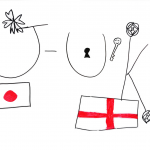evidence
Tell us what you found out –
what were people’s experiences, views or ideas for change?
Across two phases we worked with the group to explore the key policy areas that the members of the group thought were most important. We delivered a series of participative sessions and identified recommendations for both the Scottish and UK Government. In Phase 2 of the project, The Panel explored the following areas:
– The Economy, Trade and Jobs
– Rights
– Opportunities to Work, Study and Travel
– EU Funding
We worked with the group to deliver a social media campaign, meet with decision makers, produce a final report and hold a launch event with Scottish Government ministers.
A key issue for the project was making Brexit relatable to the day to day lives of children and young people. The members of the panel enjoyed using characterisation activities to explore what children and young people need to be happy, healthy and safe. We used these characters to think about how exiting the EU might affect this (i.e if fun was important – how might leaving the EU affect this).
What are your recommendations or calls to action?
Phase 1 –
Final Report – https://childreninscotland.org.uk/wp-content/uploads/2019/02/Brexit_FINAL_nobleed.pdf
Phase 2 –
Final Report – https://childreninscotland.org.uk/wp-content/uploads/2020/11/CYP_Panel_on_Europe_Report_Final.pdf
-
advice
Tell us your advice on doing participation activities - what worked well, what you enjoy, what is inclusive?
We broke the project down into the policy areas that the group wanted to focus on, at each stage background briefings were provided and we thought about how the specific issues might affect children and young people. By breaking the topic down and making it relatable to their day to day lives, we were able to engage young children in complex policy. A top trumps style activity was particularly effective for deciding what decision makers we wanted to speak to. Members of the group ranked decision makers based on their power, availability and links to the panel. Putting this in a game form made it understandable to all and allowed the group to make decisions about who they wanted to talk to most. -
impact
What do you try to change?
Throughout the project we were aware that Brexit was a complex policy area with many stakeholders. As such we knew that influencing direct change was going to be difficult. We have raised awareness of the views of children and young people on Brexit in a number of ways: In Phase 1 (2018-19) we published a final project report containing the panel’s recommendations and launched this at SCVO’s the Gathering. We also met with key Scottish Government decision makers to make them aware of the Panel’s views. In Phase 2 (2019 – 20) we conducted the following activity: – We ran a two week social media campaign in August 2020 sharing a series of infographics with the panel’s views. – We held a launch event in December 2020 with members of the panel, Scottish Government ministers and members of wider civil society – We met with key members of civil society, civil servants and Scottish Government ministers on specific topics. – We launched a final project report with the panel’s recommendations.What do you want other people to do to help?
We would like people to keep sharing our work, including with children and young people. The project reports have been written in accessible language and can be used to discuss Brexit with children and young people.


